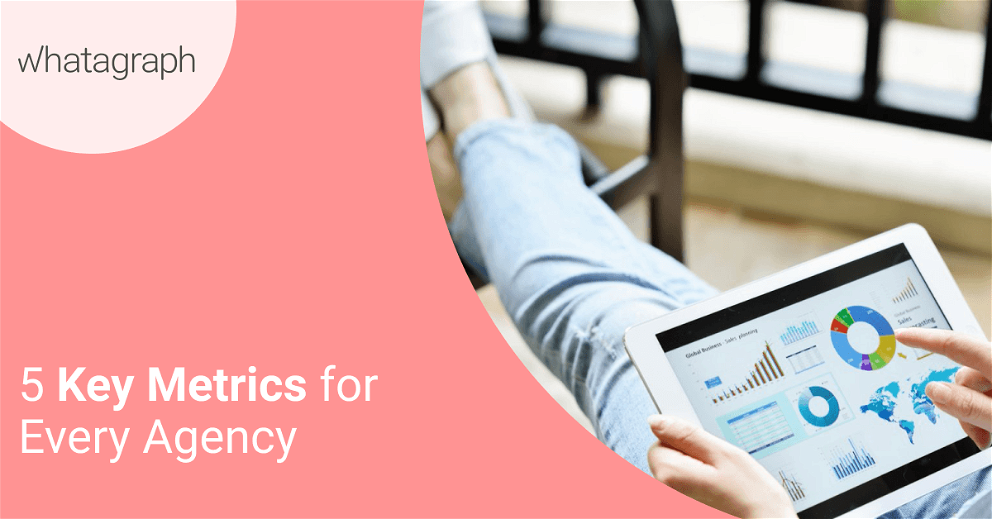It’s the wish of every agency to stay at the top of its business. But how is this possible? It’s through recognising business strengths and weaknesses. By spotting the potential growth opportunities and areas where you are losing money, you can plan strategically to win a business advantage.
5 Key Metrics Every Agency Should Be Tracking

Feb 14 2020 ● 4 min read

Table of Contents
- 1.Client Acquisition Cost
- 2. Client’s Minimum Engagement
- 3. Agency Utilisation Rate
- 4. Profitability by Client
- 5. Profit Margins
To understand your agency in every aspect, you need to monitor its progress. The ultimate approach to knowing your progress is by tracking metrics in an agency dashboard. These are measures that will prove quite useful particularly in unveiling hidden growth opportunities. Something to note is that the better KPIs (metrics) you have the better the clients, employees and more money you get.
1.Client Acquisition Cost
It’s paramount to examine and quantify your client acquisition cost. This involves assessing the cost to acquire a client relative to what you’ll make throughout their lifetime. If the value of a deal is less than the cost to pitch a client, that would mean losing your money.
To calculate client acquisition cost, add up all the sales and marketing costs over a period, then divide the total cost by the number of clients you closed during that period. How do you know if your client acquisition cost is justifiable? An acquisition cost of a fifth of the value of the deal is acceptable.
How then is considering client acquisition cost is important? It lets you predict your sales in a certain period. You also can tell the marketing strategies that are working out best. Thus, you can spend more money on them.
A customer that results in a good ROI is valuable to your Agency business.
While you consider using this agency metric, it is important to evaluate some factors. Such include the time you expect to see results. For instance, you may invest in a marketing option that won’t give you results until a later time. Where such a situation occurs, you should incorporate it in calculating the acquisition cost of a client.
2. Client’s Minimum Engagement
An agency needs to set minimum engagement per client. First, have a list of your clients and the annual worth of each in terms of gross billings and adjusted gross income. Then determine a minimum gross billing as well as the adjusted gross income. With these two, you can calculate the profitability percentage of a customer.
With the three parameters, the gross billings, adjusted gross income, and profitability percentage, you can resolve the ideal size of clients you can service comfortably. Having the right size of customers is crucial. You may have a size that is too small or too large to make any profits. The right size will enable you to provide quality services which clients are happy to pay for.
After establishing what your size is, you can use it to monitor the current client size against it. Thus, you will aim to take the necessary steps to bring the size back to the right figure. This ensures delivering delight to your customers and in return, you get reasonable profits.
3. Agency Utilisation Rate
Agency Utilisation Rate (AUR) is one of the most important agency metrics. It guides on whether employees are working effectively or not. Utilization Rate is the number of hours an employee spends on client work against the time he or she is available to work. It indicates the billing efficiency.
Different agencies have different ways of expressing the AUR. Some Agencies measure it as the billable time out of the total available hours of employees. According to industry standards, the Agency utilization Rate should be between 85% to 90%.
So first and foremost, you need to track the time of your employees. The best approach is to use a time-tracking tool. It helps to monitor both billable and non-billable hours. Thus, you can know the exact number of hours employees spend on the client’s work. Similarly, you can know the hours spent on administrative duties.
While using this agency metric, you need to consider the type of employee you are tracking. This is because some positions like the managers may show a low utilization rate. Not because they are less valuable but they provide service differently.
Nevertheless, an AUR of 100% does not always sound good. It could be that your employees spend all the available hours because they are less skilled. So all the factors need careful examination.
4. Profitability by Client
Profitability by a client is the way to zero in on the worth of a customer to your business. Keeping track of overall profitability is not enough. An agency needs to get as specific as possible as to what profit they get from each client. You might be surprised to know some hard truths.
Until you track your clients, you won’t know those who contribute handsomely to your profits. Also, knowing the difficult ones and those who cost you money would be hard. By analyzing most of your clients, decide the minimum you want to work with.
You may want to set it at 3%, 10%, or 30%. It all depends on what works best for your agency. But here we recommend working with 10%.
Understanding your client’s contribution to your overall profit will help you to evaluate much more. Like if there are clients not contributing as much, you’ll find out why and see how to find a solution.
5. Profit Margins
All other agency metrics illuminate business profits. This entirely means that metrics track business performance to ensure it’s taking in more than it’s spending. There are two ways to go. An agency can truck gross profit margin or net profit margin. An agency can track the gross profit margin or the net profit margin.
gross profit is the leftover after deducting the cost of goods sold. The recommended gross profit margin is between 50% and 60% per month. To arrive at the gross profit margin you should take net sales, deduct the cost of goods sold and then divide their difference by the net sales and express this as a percentage.
If your business is delivering less than this, you should find out why. A lower gross profit margin may mean that you’re not charging enough to provide your goods or services.
On the other hand, the net profit is the leftover after paying all the bills and salaries. Experts indicate that an agency should have a margin of 15%-20% every month. However, agencies in growth mode should show a net profit of 8%-12%. So what’s this margin? It’s the percentage of net sales less cost of goods sold and all expenses, then divide what you get by net sales.
Published on Feb 14 2020

WRITTEN BY
Gintaras BaltusevičiusGintaras is an experienced marketing professional who is always eager to explore the most up-to-date issues in data marketing. Having worked as an SEO manager at several companies, he's a valuable addition to the Whatagraph writers' pool.
Get marketing insights direct to your inbox
By submitting this form, you agree to our privacy policy









